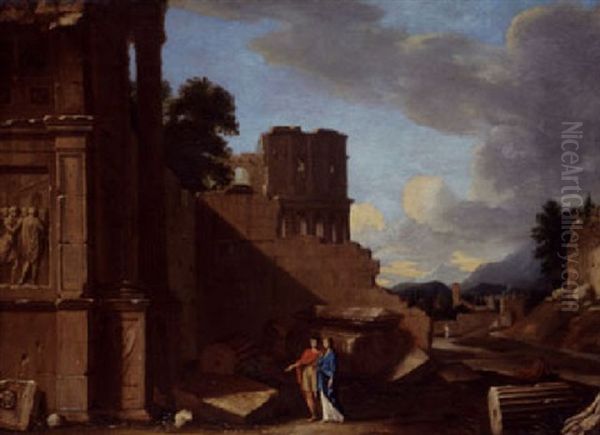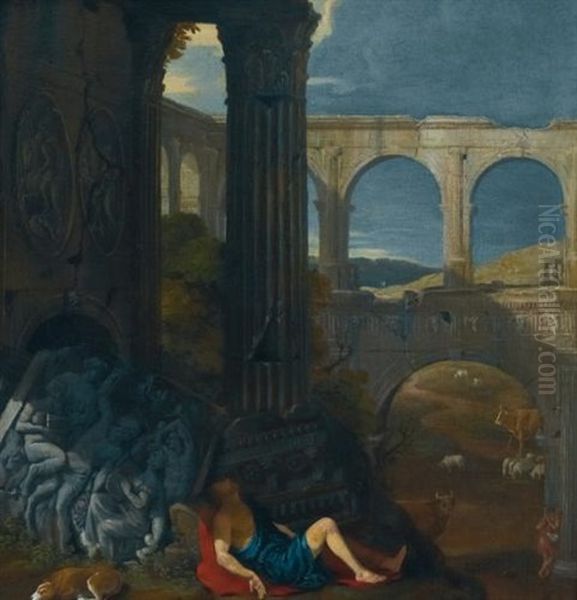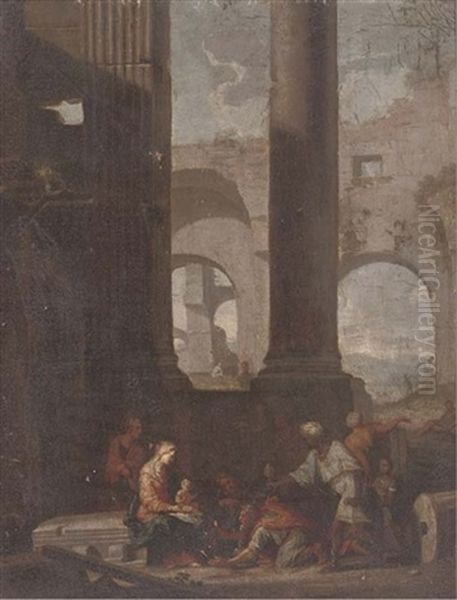Jean Lemaire, a French painter of the Baroque era, holds a distinct, if somewhat overshadowed, place in the annals of art history. Born around 1598 in Dammartin-en-Goële, near Paris, and passing away in Gaillon in 1659, Lemaire carved out a niche for himself primarily as a painter of classical landscapes and, most notably, architectural scenes, often imbued with a sense of historical grandeur and imaginative reconstruction. His close association and collaboration with the towering figure of Nicolas Poussin led to the enduring, though informal, cognomen "Lemaire-Poussin," a testament to their intertwined artistic paths rather than a formal part of his name. This article delves into the life, work, collaborations, and artistic milieu of Jean Lemaire, seeking to illuminate his contributions to 17th-century French and Roman art.
Early Life and Artistic Formation
Details of Jean Lemaire's earliest years and initial training are somewhat sparse, a common challenge for art historians studying artists who were not of the absolute first rank of fame in their own time. However, it is generally accepted that he received his foundational artistic education under Claude Vignon (1593–1670). Vignon was a versatile and eclectic painter, known for his dynamic compositions and rich color palette, influenced by Caravaggism from his time in Rome, as well as by Venetian and even Mannerist tendencies. Training with such an artist would have exposed Lemaire to a broad range of stylistic possibilities and technical approaches current in Paris during the early 17th century.
Like many ambitious artists of his generation from across Europe, Lemaire was drawn to Rome, the undisputed center of the art world. He is documented in the Eternal City by 1613, though some sources suggest his arrival might have been later, perhaps around 1624, coinciding more closely with Poussin's own arrival. Rome offered unparalleled opportunities: direct study of classical antiquities, masterpieces of the High Renaissance, and the vibrant contemporary art scene shaped by figures like Caravaggio (though deceased by then, his influence was potent), Annibale Carracci, and the burgeoning Baroque movement. For an artist with a predilection for architecture, Rome was an inexhaustible museum, its ruins and surviving structures providing endless inspiration.
The Roman Milieu and the Poussin Connection

Rome in the 1620s and 1630s was a melting pot of artistic talent. French artists, in particular, formed a significant expatriate community. It was in this environment that Lemaire's path fatefully converged with that of Nicolas Poussin (1594–1665). Poussin, who arrived in Rome in 1624, would become the leading figure of French Classicism, his work characterized by intellectual rigor, clarity of composition, and profound engagement with classical themes.
The relationship between Lemaire and Poussin became exceptionally close. They are known to have shared lodgings for a period; indeed, Poussin is recorded as living with Lemaire in 1628. More significantly, they engaged in artistic collaboration, a practice not uncommon at the time, especially when specialized skills were involved. Lemaire's forte was architectural painting – the precise and evocative rendering of classical buildings, both real and imagined. Poussin, while a master of figure composition and narrative, often benefited from Lemaire's expertise in creating the elaborate architectural settings that many of his historical and mythological scenes required.
This collaboration is noted by early biographers like André Félibien, who was a contemporary and friend of Poussin. Félibien explicitly mentions Lemaire as one of Poussin's rare collaborators, highlighting the specialized nature of their partnership. This working relationship was so recognized that it cemented the "Lemaire-Poussin" moniker, distinguishing him from other artists named Lemaire and permanently linking his identity to that of his more famous compatriot.
Collaborative Ventures and Artistic Symbiosis
The nature of their collaboration typically involved Lemaire painting the architectural backgrounds, while Poussin focused on the human figures that animated these scenes. This division of labor allowed each artist to play to his strengths, resulting in works that combined Poussin's narrative power and figural grace with Lemaire's convincing and often atmospheric architectural settings.
One of the most frequently cited examples of their collaboration, or at least Lemaire's contribution to a Poussin work, is Poussin's The Adoration of the Golden Calf (National Gallery, London). While the figures are unmistakably Poussin's, the architectural elements in the background are often attributed to Lemaire, showcasing his skill in creating a plausible ancient environment. Similarly, for Poussin's commission from Cardinal Francesco Barberini, The Death of Germanicus (Minneapolis Institute of Art), completed in 1628, it is plausible that Lemaire contributed to the design or execution of the architectural backdrop, given their close association at this time.

Their collaboration extended beyond easel paintings. When Poussin was summoned back to Paris by King Louis XIII and Cardinal Richelieu in 1640 to work on the decoration of the Grande Galerie of the Louvre Palace, Lemaire was among the artists who assisted him. This prestigious project, overseen by François Sublet de Noyers, the Surintendant des Bâtiments du Roi, was a major undertaking. Lemaire's role would have been to execute architectural perspectives and decorative elements according to Poussin's overall designs. This period in Paris, from 1640 to 1642, further solidified their professional bond, though Poussin, unhappy with the court environment and intrigues involving artists like Simon Vouet (1590–1649) and Jacques Fouquier (c. 1580/1590–1659), eventually returned to Rome.
Lemaire also received independent commissions that showcased his architectural specialty. He is known to have proposed designs for a series of academic classical architectural landscapes for King Philip IV of Spain's Buen Retiro Palace in Madrid, a major decorative project that involved numerous artists, including Claude Lorrain (1600–1682) and Jan Both (c. 1610/18–1652). This indicates Lemaire's reputation as a specialist in this genre was recognized at the highest levels.
Lemaire's Distinctive Artistic Style: Architect of Imaginary Worlds
While often discussed in relation to Poussin, Jean Lemaire developed a distinctive artistic voice, particularly in his independent works. He specialized in what are known as vedute (views, often of cityscapes or architectural ensembles) and capricci (architectural fantasies, where real and imaginary elements are combined). His paintings are characterized by a profound understanding of perspective, a meticulous attention to architectural detail, and a love for the grandeur of classical antiquity.
Lemaire's architectural scenes are not mere topographical records. They are often idealized reconstructions, sometimes depicting famous Roman ruins like the Colosseum or the Forum, but frequently imbued with a poetic or melancholic atmosphere. He studied ancient Roman architecture through direct observation but also through Renaissance treatises and engraved sources, such as those by Sebastiano Serlio or Andrea Palladio. This scholarly approach allowed him to create convincing, if sometimes imaginative, reconstructions of ancient splendor.
His compositions are typically well-ordered, with a clear geometric structure that guides the viewer's eye into the pictorial space. Light plays a crucial role, often used to highlight architectural forms, create dramatic contrasts, and evoke a specific mood – sometimes the bright clarity of a Mediterranean day, other times the soft glow of twilight. Small figures often populate these scenes, not as the primary subjects in the Poussinesque sense, but rather to provide scale, animate the space, and sometimes allude to mythological or historical narratives. Works such as Roman Capriccio with Figures, Architectural Capriccio with Figures before a Palace, or Classical Landscape with Figures (titles vary across collections and attributions) exemplify these characteristics.

In some works, like Mercury and Argus or Theseus Finding his Father's Arms (Prado Museum, Madrid), the narrative element is more prominent, yet the architectural setting remains a dominant feature, meticulously rendered and integral to the composition. The figures in his independent works sometimes show a "Poussin-esque" quality, a testament to the influence of their close working relationship, or perhaps indicating occasional reciprocal influence or shared studio models.
Distinguishing Lemaire: The Painter, Not the Poet
It is important to address a potential point of confusion. Art history and literature feature another prominent figure named Jean Lemaire: Jean Lemaire de Belges (c. 1473 – c. 1525). This earlier Lemaire was a Walloon poet, chronicler, and pamphleteer of the Renaissance, known for works like Les Illustrations de Gaule et Singularitez de Troye. He was a significant literary figure, associated with the Burgundian-Habsburg court and later the French court.
Jean Lemaire the painter (c. 1598–1659), the subject of this article, belongs to a later generation and a different artistic discipline. While both were Francophone and culturally significant, their domains were distinct. The painter Lemaire's legacy lies in the visual arts, specifically in his contribution to landscape and architectural painting within the classical tradition.
Contemporaries and the Wider Artistic Context
Lemaire's career unfolded during a rich period for landscape and architectural painting. In Rome, he would have been aware of the work of artists who specialized in similar genres. The Fleming Paul Bril (1554–1626) was an established landscape painter in Rome. Later, the Dutch Italianates, such as Cornelis van Poelenburgh (1594–1667) and Bartholomeus Breenbergh (1598–1657), were active, creating idealized Italian landscapes often populated with biblical or mythological figures.
Claude Lorrain, another French expatriate in Rome, became the supreme master of the idealized classical landscape, his works celebrated for their poetic rendering of light and atmosphere. While Claude's emphasis was more on the pastoral and the effects of light on nature, Lemaire's focus was more sharply on architectural structures. Gaspard Dughet (1615–1675), Poussin's brother-in-law and sometimes pupil, also specialized in classical landscapes, often with a wilder, more romantic feel than Poussin's own.
The genre of architectural painting, or veduta, was also being developed by Italian artists. Viviano Codazzi (c. 1604–1670), an Italian painter of architectural views, was a contemporary active in Rome and Naples, known for his perspectivally accurate and often dramatic depictions of classical ruins and contemporary buildings. Later in the century and into the 18th century, artists like Giovanni Paolo Panini (1691–1765) would bring the veduta and capriccio to new heights of popularity, building on the traditions established by painters like Lemaire and Codazzi.

Back in France, the artistic scene was dominated by figures like Simon Vouet, who brought the Italian Baroque style to Paris, and later Charles Le Brun (1619–1690), who, under Louis XIV, would codify French academic classicism. Philippe de Champaigne (1602–1674), a Flemish-born painter active in Paris, represented a more austere and deeply religious form of classicism. Artists like Eustache Le Sueur (1616–1655) and Jacques Stella (1596–1657), a close friend of Poussin, also contributed to the French classical tradition. Lemaire's work, with its emphasis on order, clarity, and classical motifs, aligns with the broader currents of French Classicism, even though much of his formative work was done in Rome.
Later Career and Legacy
After Poussin's definitive return to Rome in 1642, Lemaire remained in France. He is documented as working in Paris and later in Gaillon, in Normandy, where he held the post of keeper of the royal collections at the Château de Gaillon from 1647 until his death in 1659. This position suggests a degree of official recognition and stability in his later years.
Despite his skills and notable collaborations, Jean Lemaire has remained a somewhat enigmatic figure, often viewed through the prism of his association with Poussin. The very nature of their collaboration, where Lemaire's architectural contributions were integrated into Poussin's larger compositions, sometimes makes it challenging to definitively isolate his hand or assess his independent oeuvre fully. Attributions can be complex, and works solely by Lemaire are less numerous or less prominently displayed in major collections compared to those of Poussin or Claude Lorrain.
However, his influence should not be entirely discounted. His specialized skill in architectural painting contributed significantly to the works he collaborated on with Poussin, enhancing their classical settings and historical verisimilitude. As an independent artist, he produced refined and evocative architectural landscapes that stand as worthy examples of the genre. He was part of a broader movement that celebrated classical antiquity and sought to integrate its forms and spirit into contemporary art. His dedication to architectural representation provided a model for later painters specializing in vedute and capricci.
The study of Jean Lemaire continues, with art historians working to clarify attributions, reconstruct his catalogue raisonné, and better understand his specific role within the Franco-Roman art scene of the 17th century. His works can be found in various museums, including the Louvre in Paris, the Prado in Madrid, and other collections in Europe and North America.
Conclusion: An Architect of Painted Worlds
Jean Lemaire, or Lemaire-Poussin, was more than just an assistant to a great master. He was a talented specialist in his own right, an artist whose vision was captivated by the order, grandeur, and enduring beauty of classical architecture. His ability to translate these qualities into paint, creating convincing and often poetic architectural settings, was a significant asset to Nicolas Poussin and a hallmark of his own independent work.
While he may not have achieved the universal fame of some of his contemporaries like Poussin, Claude Lorrain, or even his master Claude Vignon, Jean Lemaire made a valuable contribution to the art of his time. He helped to shape the visual language of classical landscape and architectural painting, genres that would continue to flourish long after his death. His meticulous renderings of ancient structures, whether real or imagined, invite viewers into a world where the past is palpably present, its architectural glories reconstructed with skill and artistic sensitivity. As an architect of painted worlds, Jean Lemaire deserves recognition for his unique vision and his dedicated craftsmanship within the rich tapestry of 17th-century European art. His collaboration with Poussin remains a fascinating example of artistic synergy, while his own architectural fantasies stand as a testament to his individual talent.